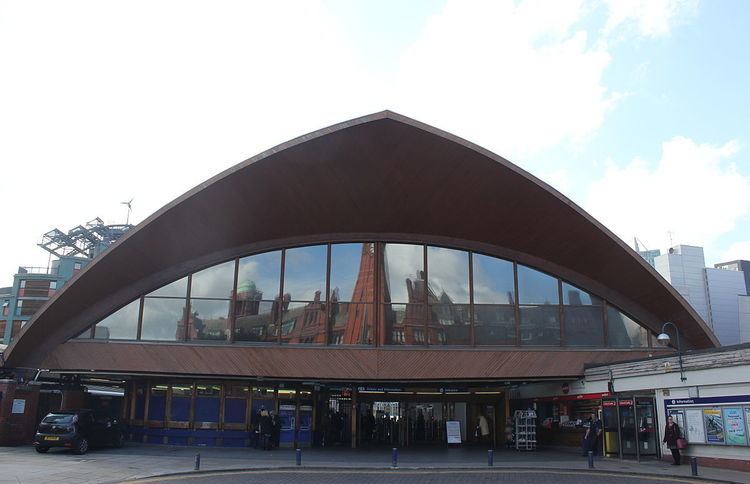Station code MCO DfT category C1 Number of platforms 5 | Grid reference SJ840974 Managed by Northern 2011/12 7.077 million | |
 | ||
Address Manchester M1 5NF, United Kingdom Pte Transport for Greater Manchester | ||
Manchester Oxford Road railway station is a railway station in Manchester, England, at the junction of Whitworth Street West and Oxford Street. It opened in 1849 and was rebuilt in 1960. It is the second busiest of the five stations in Manchester city centre.
Contents
The station serves the southern part of Manchester city centre, the University of Manchester and Manchester Metropolitan University, on the line from Manchester Piccadilly westwards towards Warrington Bank Quay, Chester, Llandudno, Liverpool, Preston and Blackpool. Eastbound trains go beyond Piccadilly to Crewe, Leeds and Sheffield.
The station is notable for its laminated wood structures and was Grade II listed in 1995. English Heritage describes it as a "building of outstanding architectural quality and technological interest; one of the most dramatic stations in England".
History
The station opened as Oxford Road on 20 July 1849 and was the headquarters of the Manchester, South Junction and Altrincham Railway (MSJAR) until 1904. The station had two platforms and two sidings, with temporary wooden buildings. To allow for extra trains in connection with the Manchester Art Treasures Exhibition in 1857, extra platforms and sidings were built. In 1874, the station was completely rebuilt, providing two bay platforms and three through platforms. Further reconstruction took place during 1903-04. From 1931 it was served by the MSJAR's 1500V DC electric trains between Altrincham and Manchester Piccadilly.
From July 1959, Altrincham electric trains were cut back from Piccadilly to terminate at Oxford Road in two new bay platforms. The station's other lines were re-electrified at 25 kV AC. The whole station was again rebuilt and reopened on 12 September 1960. When Manchester Central railway station closed in 1969, further rebuilding took place: one of the bay platforms was taken out of use and a new through platform provided (platform 1), the others being renumbered accordingly. The track layout was changed so that there were four through and one bay platforms. In 1971 the Altrincham line was re-electrified at 25 kV AC and the 1930s DC trains withdrawn; from then on, local trains from Altrincham ran through to Piccadilly and on to Crewe. Oxford Road thus became predominantly a through station.
Use of the station increased in 1988 when the Windsor Link between Deansgate and Salford Crescent opened, connecting lines to the north and south of Manchester. This led to further investment in the station, including the installation of computer screens.
In 1992, the Altrincham line stopping service was converted to light rail operation for the Manchester Metrolink. Oxford Road, once served almost entirely by suburban stopping trains, now has many more longer-distance services.
The station, a Grade II listed structure, requires frequent maintenance. In 2004, the station roof was partially refurbished to prevent leaking. In 2011, the platform shelters, seats and toilets were refurbished at a cost of £500,000. In 2013, the station received a £1.8 million renovation to improve access, including lifts and an emergency exit.
Future
In the Northern Hub plans, the platforms will be extended to allow use by longer trains. The bay platform will be removed to allow the other platforms to be extended. Under controversial plans much of the nearby area's Victorian character will be razed, including the Dickensian Salisbury pub, and the group of streets nearby known as 'Little Ireland'.
Architecture
The station had become dilapidated by the 1950s, and in connection with the electrification and modernisation programme of the Manchester to London line in 1960, the old buildings were replaced by the current structure by architects William Robert Headley and Max Clendinning and structural engineer Hugh Tottenham. It was designed in a distinctive style in concrete and wood with curves bringing to mind the Sydney Opera House.
The station is a grade II listed building. In Pevsner's Architectural Guide - Manchester it is described as
One of the most interesting and innovative buildings of the period ... the most ambitious example in this country of timber conoid shell roofing.
and
One of the most remarkable and unusual stations in the country both for the architectural form and the technological interest...it is the most dramatic and it is an important example of the deployment of timber to achieve large roof spans incorporating clerestory lighting.
The choice of timber was forced by the weak viaduct on which the station is situated; anything heavier could have compromised its structural strength. The station has three overlapping conoid structures although they are only viewable from above. The light conoid roofs allow for a column-free interior space, maximising space and reducing load.
Despite its architectural acclaim, the structure began to deteriorate within ten years. The roof started to leak and for years the station's platform buildings were encased in scaffolding and other metalwork, partly to support the structure and prevent material falling on the platforms and passengers. Partial remedial refurbishment was completed in 2004.
Service pattern
First TransPennine Express used to run the service from Manchester Airport to Blackpool North but this was passed on to the new Northern franchise on the 1st April 2016.
This is reduced on a Sunday, most services operating hourly. There are various other peak services. All eastbound trains (those to Hazel Grove, Scarborough, Nottingham, Norwich and Manchester Airport) also call at Manchester Piccadilly.
